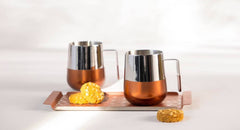Stainless Steel Cookware for Everyday Cooking: Tips from the Pros
For regular use, both amateur and professional cooks really appreciate stainless steel cookware as a top-notch material. Given its high heat conductivity, non-reactive surface, and durability, this kitchen necessity is a must-have. These professional tips should help you maximize your stainless steel cookware experience.
Exploring Stainless Steel Grades:
Not all stainless steel cookware is made equal. For kitchen usage, the most common grades are 18/10 and 18/8, which indicate the chromium and nickel content. For instance, 18/10 stainless steel, with its higher nickel concentration, enhances both gloss and corrosion resistance.
Pro tip: Look for stainless steel vessels for cooking stamped 18/10 if you want the best quality. Being stain and corrosion-resistant ensures its strength, guarantees its long lifespan, and keeps your cookware looking pristine.
Preheating:
Properly preheating your stainless steel cookware is crucial to prevent food from sticking. Medium heat is ideal—let the pan heat for a few minutes before adding oil or food. Test the readiness by adding a few drops of water; if they sizzle and vanish quickly, the pan is ready.
Avoid overheating the skillet to prevent food from burning and sticking. Most cooking techniques are effectively managed with medium heat, which is generally sufficient for a variety of recipes.
Use the proper cooking oils:
When cooking in stainless steel vessels, it’s important to choose oils with the right smoke points. Because stainless steel cookware retains heat so well, oils like canola, grapeseed, or peanut oil are better suited for frying or sautéing due to their high smoke points.
Cooking tips: Olive oil, with its lower smoke point, is better used for low to medium heat or as a finishing oil to enhance flavors.
How to Clean Steel Utensils Effectively:
While stainless steel cookware is relatively easy to clean, incorrect cleaning methods can cause discoloration or residue buildup. Avoid using abrasives that can scratch the surface. Instead, opt for mild cleaners and non-abrasive sponges. For stuck-on food, soaking the pan in hot, soapy water for a few minutes helps.
If you encounter difficult stains, use a paste of baking soda and water—it works wonders. Learning how to clean steel utensils correctly will ensure your cookware maintains its shine and performance for years to come.
Seasoning for Non-Stick Benefits:
While not as crucial as seasoning cast iron, you can create a semi-non-stick surface on stainless steel cookware. To do this, heat the pan, coat it thinly with oil, and let it cool before wiping off the excess. Repeating this step occasionally helps maintain the non-stick properties, especially if you find food sticking more than usual.
Avoid high heat for prolonged periods:
Although stainless steel vessels for cooking can withstand high heat, prolonged exposure can cause warping and discoloration. Stick to medium or medium-high heat for most cooking techniques. Reserve high heat for tasks like boiling water or searing meat, then reduce the heat to preserve the pan’s integrity.
Storage of Your Cookware:
Proper storage extends the lifespan of your stainless steel cookware. Hanging your pots and pans on a pot rack helps to prevent scratches and keeps your cookware in top condition for easy access.
Acknowledging Food Reactions:
Even though stainless steel cookware is non-reactive, it’s wise to be cautious when cooking highly acidic foods like tomatoes or citrus for extended periods. Although stainless steel vessels for cooking may develop mild pitting over time, they won’t react like copper or aluminum. However, for very long cooking sessions with acidic ingredients, consider using enameled cast iron as an alternative.
Conclusion:
Stainless steel cookware is a dependable and adaptable choice for everyday cooking. Understanding its features and following professional standards will help you maximize its lifetime and performance. Whether you're boiling sauces, searing meat, or sautéing vegetables, stainless steel cookware is an excellent tool when used and maintained properly.







Leave a comment
Note: Comments are published after moderation.